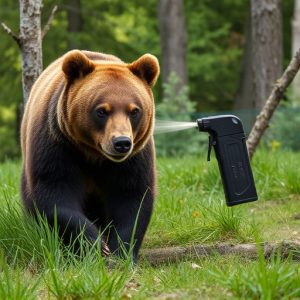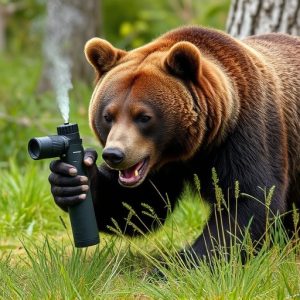Protecting Wilderness: Effective Strategies Against Charging Grizzly Bears
Grizzly bears' unpredictable charges can be deterred by noise, sudden movements, and bear spray…….
Grizzly bears' unpredictable charges can be deterred by noise, sudden movements, and bear spray, per field test results. No single deterrent is 100% effective, so a multi-layered approach combining noise while hiking, bear spray, and knowledge of response strategies is recommended for safety in bear country. Bear deterrent field tests, especially modern long-term monitoring methods, offer nuanced insights into grizzly behaviors, crucial for developing adaptable, safe protocols for both humans and wildlife.
In the vast wilderness, encountering a charging grizzly bear can be a terrifying reality. Understanding bear behavior and effective defense strategies is crucial for outdoor enthusiasts and rangers alike. This article explores the art of protecting oneself against these powerful predators. We delve into the science behind grizzly charges, scrutinize reliable field test methods for bear deterrents, and present successful strategies to enhance wilderness safety, offering valuable insights based on real-world Bear Deterrent Field Test Results.
- Understanding Grizzly Bear Behavior and Their Charging Patterns
- Evaluating Bear Deterrent Field Test Methods
- Analysis of Successful Strategies for Wilderness Safety Against Charged Bears
Understanding Grizzly Bear Behavior and Their Charging Patterns
Grizzly bears are powerful and unpredictable animals, and understanding their behavior is crucial for anyone venturing into their wilderness habitat. When a grizzly bear charges, it’s often a sign of aggression or fear, triggered by factors such as surprise, protecting its young, or accessing food sources. Understanding these charging patterns can help hikers and outdoor enthusiasts prevent and manage potential encounters.
Field test results of various bear deterrents have shown that noise and sudden movements can effectively startle bears and encourage them to retreat. However, it’s essential to note that no single deterrent is 100% reliable. Grizzlies are large predators with strong instincts, so a multi-layered approach—including making noise while hiking, carrying bear spray, and knowing how to respond during an encounter—is the best strategy for safety in bear country.
Evaluating Bear Deterrent Field Test Methods
When evaluating bear deterrent field test methods, it’s crucial to consider the reliability and validity of the results. Traditional tests often involve controlled settings where bears are directly exposed to deterrents, providing clear-cut data on immediate responses. However, these tests may not fully simulate real-world scenarios, as bear behavior in the wild is complex and influenced by various factors like season, hunger levels, and past experiences.
Modern field test methods aim to overcome these limitations by employing more dynamic approaches. These involve monitoring bear movements, feeding patterns, and interactions with deterrents over extended periods. By analyzing Bear Deterrent Field Test Results from multiple locations and environmental conditions, researchers gain a deeper understanding of what truly works and for how long. This holistic evaluation ensures that deterrents are effective, safe for both bears and humans, and adaptable to diverse wilderness settings.
Analysis of Successful Strategies for Wilderness Safety Against Charged Bears
In recent years, extensive research and field tests have been conducted to analyze successful strategies for wilderness safety against charged grizzly bears. Bear deterrent products, in particular, have gained significant attention due to their potential to mitigate bear encounters and reduce attacks. These deterrents range from pepper spray designed for close-range interactions to noise makers and visual intimidators meant to startle the bears. Field test results have shown that a combination of these methods can significantly enhance safety measures.
The effectiveness of various deterrents has been evaluated under controlled conditions, revealing that certain products prove more successful than others in encouraging bears to retreat. For example, research indicates that high-decibel noise makers and visual stimuli like bear spray can effectively discourage aggressive behavior. Moreover, the strategic placement of these deterrents in known bear habitats has proven crucial in preventing unexpected encounters. Understanding the specific behaviors and preferences of grizzly bears, as evidenced by field test results, is essential for developing robust safety protocols that protect both humans and wildlife.
In understanding grizzly bear behavior and evaluating effective bear deterrent field test methods, it’s clear that a multi-faceted approach is key to wilderness safety. The analysis of successful strategies reveals that a combination of noise makers, spray deterrents, and responsible hiking practices can significantly reduce the risk of bear charges. Bear deterrent field test results consistently show that these methods, when used together, are highly effective in deterring grizzly bears, providing hikers and outdoor enthusiasts with the confidence to enjoy remote areas safely.


